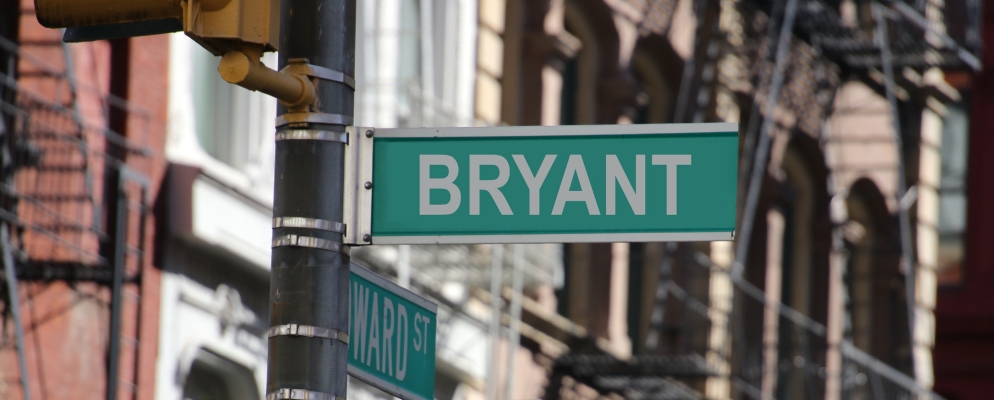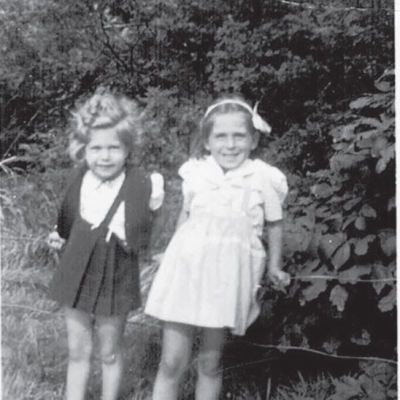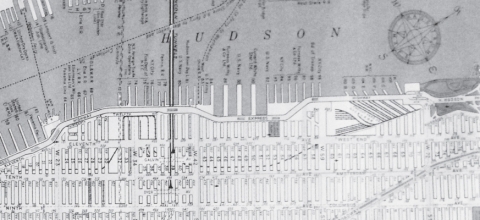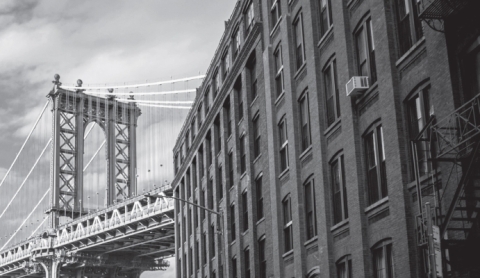Bryant Avenue
It is October 1948 in the Bronx, between Rosh Hashanah and Yom Kippur. World War II ended three years ago. The State of Israel is five months old.
I am walking from my red brick apartment building at 750 Bryant Avenue hand in hand with Roberta, my neighbor and classmate. We are six and a half years old and just starting first grade. We turn left and skip down Bryant Avenue in our fall coats and flesh-colored warm stockings; no pants for girls. On the way down we pass an empty lot which goes steeply down to the street below, no apartment buildings, a feeling of being in the midst of nature.
The lot's most memorable features are its abundance of allergy-causing ragweed and a very large granite boulder which a boy once declared to have been deposited when the ice age receded. As Bronx winters are always frozen, I wonder why this seems to have such importance. Then we pass a home for German girl orphans, whom we never, ever see. A big hall on that property, accessed from our street, is used during the high holidays as a synagogue. Sticky burrs are abundant in September and October and we children throw them at each other outside of the makeshift synagogue as the adults pray for our fates.
At the end of the block, we turn right and cross Hunts Point Avenue, going up Spofford Street. There are school monitors at each cross street, but how many people have cars in 1948? The iceman who brings huge blocks of ice in the summer comes by cart and horse; likewise, the knife-sharpener, the alte-zachen man. The danger is from buses coming down Hunts Point Avenue, heading to their last/first stop. We are at the tip of the Bronx where a small eighteenth century cemetery sits quietly and unnoticed, where the borough slips off into the East River.
My father never takes the bus, though it is a half hour's walk to the subway station on Hunts Point Avenue. He walks there in the morning, back home in the afternoon. We do not have an extra penny to spend on bus fares.
The Bronx is hilly. Our castle-like school sprawls up and down an entire block. On the bottom is the boys' entrance; in the middle are the foreboding doors through which the teachers pass, and the dreaded, inscrutable principal. On the top of the hill is the girls' entrance, on Coster Street. We line up and wait for the bell to ring at nine o'clock when we all file in politely and learning begins.
Coster Street is a border of sorts. Jews don't live in that neighborhood. There is a church opposite the school. 750 Bryant Avenue is all Jewish except for the janitor, who has an apartment in the basement and shows us his Christmas tree each year. He keeps cats to ward off creepy-crawlies. One other family in the building is also not Jewish. They have a cocker spaniel dog; it seems only Jews do not keep pets - or cannot afford them. The rest of Bryant Avenue and surrounding streets are also Jewish – kosher butchers, delicatessens, bakeries.
P.S. 48 has a kindergarten as part of the school's program. Miss Burke was a mean-hearted teacher and every day, after a couple of hours in her nasty company, I would bring up my food. I was skinny and tiny, the second shortest in my class.
Gerald was in my kindergarten class and now is in my first-grade class. We like to play together and he sometimes gives me bubble gum which my mother won't permit me to chew. Miss O'Connor is our first-grade teacher and she is lovely. I am happy now that I am free of wicked Miss Burke.
I know about the Holocaust vaguely, because one day my mother sent me to bring a newspaper from Moishe's candy story, down the block. We go to Moishe's and order ice cream sodas every time my father gets a raise from the ironworker's shop; but more frequently there is no work and he gets laid off. In that newspaper, on the front page, was a photo of corpses in mass graves which did not register with me as horrific, but my mother cried—I had never seen her cry before, and what shocked me so that I would remember it always, was the fact of her crying.
On this cool October morning, Roberta and I are going uphill to the girls' entrance, and Gerald and his brother Philip, a huge nine-year old, are coming down to theirs. Philip blocks my way – "Are you Jewish?" he asks. "Yes" I say. What could be more natural? And then he punches me hard in the stomach. Big Philip versus tiny me. The wind goes out of me and I ask, "Why did you do that?" And then I cry.
I go to school and print in awkward capital letters: Run Dick, run. See Dick run. I don't tell Ms. O'Connor because I am afraid, but I do tell my parents. Philip is not seen again for a long time and I grow up, with the concentration camps sitting on my memory, through periods of believing I am living in a true melting pot of tolerance, interspersed with not infrequent anti-Jewish remarks and incidents, until I am seventeen years old, leave Bryant Avenue, board the S.S. Zion, and choose to live in Israel where I am just another human being, and sometimes I remember Philip, the first straw.











Comments